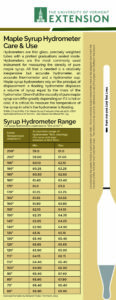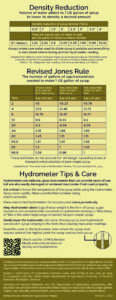Temperature Compensation Chart for Maple Syrup Hydrometers
The University of Vermont Extension’s “New” temperature compensation chart syrup hydrometers. 


Showing 1 – 10 of 210 resources
The University of Vermont Extension’s “New” temperature compensation chart syrup hydrometers. 


New Temperature Compensation Chart for Syrup Hydrometers developed by the University of Vermont Extension
This ongoing podcast features interviews with researchers and educators about topics related to maple production and marketing.
An examination of why and how maple sugarmakers can make their operations carbon-neutral.
This tool is meant to identify off-flavors in syrup, and link the particular sensory experience to a specific defect and category that explains why the defect has occurred. Additionally, this tool serves as a user-friendly representation of the Vermont Agency of Agriculture Farms and Markets (VAAFM) “Maple Syrup Off-Flavors” manual.
The map of maple is a sensory tool, allowing you to explore all the wondrous possibilities of Vermont maple syrup. It offers some hints for tasting on your own.
Business is booming if you own a commercial sugar bush! As forest managers, this means more and more of us are hearing from landowners interested in starting or maintaining a sugar bush. Unfortunately, if you are like us, you did not learn about maple syrup in forestry school. This episode’s guest, Mark Isselhardt, Extension Maple Specialist with the University of Vermont, helps us unpack the fundamentals of sap production, sugar bush management, and how the industry has changed in the 21st century.
Judged maple syrup contests originated as a friendly competition amongst producers in the early part of the 20th century. More recently, these competitions have evolved into a valuable opportunity for producers to improve their practice and evaluate their production methods. The grading system employed in the judging process facilitates communication about the uniqueness of pure maple syrup. The world standard definitions, uniform grading system, and related guidelines have been developed to promote uniformity throughout the maple industry. In competition, the same standards apply, regardless of where the contest is being held. As maple judging has evolved, so have the guidelines. Every region has contributed to the refinement of these criteria, as the process of judging has become more sophisticated and widespread. Producers throughout the US and Eastern Canada have begun to embrace maple judging as they understand the value of knowing how to make syrup to a high standard. Consumers benefit from the emphasis on taste, and off-flavored syrup is kept out of the market.
While there are both good and bad impacts on maple syrup producers due to climate change, overall, the effects will be negative. On the plus side, longer summers mean longer growing seasons for maple trees. However, regionally this longer growing season will increasingly be accompanied by periods of extended drought – particularly in more southern latitudes. This in turn may hinder root growth and performance. As maple syrup producers we are aware that anything which negatively effects maple tree roots is a concern because the roots are the origin for sap movement in the spring.
Pure Maple Syrup production in Wisconsin is regulated primarily by the US Food and Drug Administration (FDA) and Wisconsin Department of Agriculture, Trade and Consumer Protection (DATCP). This document assembles the various components of information to assist veteran and new producers of maple syrup in Wisconsin with the basic federal and state regulations impacting the maple syrup industry.